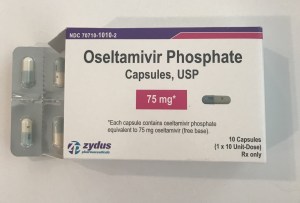
During cold and flu season, there are several medical treatments that are hotly contested. Most commonly, it is whether or not to get a flu vaccine. A close second is whether or not to give Tamiflu to a patient who has been diagnosed with influenza. Every year we have to dispel the myth that the flu is just a bad cold. Not only does it feel a lot worse, there are more severe complications. Thousands of people die of the flu in the United States every year. Therefore, it makes sense to have an antiviral medication that can fight it off. Unfortunately, the medication we have isn’t as great as we would like and does come with side effects. Let’s break it down.
What is Tamiflu?
Oseltamivir, otherwise known as Tamiflu, is a neuraminidase inhibitor. That means it blocks the protein which enables the release of viral particles to spread of virus. Preventing viral replication and spread reduces length of infection and symptoms. This works well in cell culture, but that doesn’t always translate well in human use.
What is the benefit of Tamiflu use?
Tamiflu can reduce the length of symptoms by 1-2 days if it is started within the first 24-48 hours of symptoms. A 1-2 day reduction may not seem like a lot, but if you need to get your child back to school and/or get yourself back to work, it can be helpful. I have definitely observed some patients with a more rapid recovery when taking Tamiflu. Unfortunately, well done studies have not been shown to reduce the risk of complications of the flu, including death. There are some observational studies that this is the case, however, and the CDC still recommends its use in high risk groups. These include those with asthma, diabetes, sickle cell, heart disease, kidney disease or liver disease. Also included are children on aspirin therapy and those under 2 years of age.
What are the side effects of taking Tamiflu?
The most common side effects we see are headache, stomach ache, nausea and vomiting. Because many patients with the flu are already vomiting, this makes it difficult to start the medication. The other side effect we can see is a change in behavior or hallucinations. While this is very rare, it is pretty scary. That means assessing the risks v benefits is needed before initiating Tamiflu.
Bottom line:
The best method of not only preventing the flu but preventing complications if you should get the flu, remains vaccination. For otherwise healthy children who have been vaccinated, especially those with symptoms for over 48 hours, taking Tamiflu my not have much added benefit. For anyone who is considered high risk, including healthy children without a seasonal flu shot, Tamiflu remains a viable option if symptoms are have been present less than 48 hours or if they are getting worse. Of course, if you think your child has the flu, have them seen by the doctor right away to assess the potential use of Tamiflu as each patient should be considered case by case. Once your child is diagnosed with the flu, whether or not they are on Tamiflu, have them seen right away if the fever does not resolve, the fever goes away and returns, there is any difficulty breathing, or they seem to be less alert.








Leave a Reply